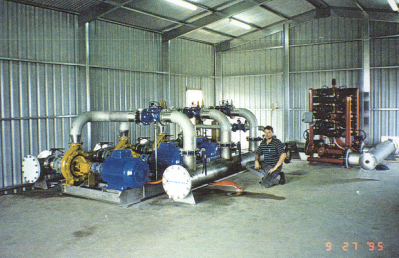

“Pumping and Hydraulics’ Solutions for Irrigation and Water Supply”

ABN: 92 105 345 506
Stainless Steels
If you have ever had any involvement with stainless steel, you will know that it can be both your best friend and your worst enemy!
Commencing with early experiences with cast 316SS pumps (5,000kW units) for major water supply pumps for SA Water in the 1970’s to all stainless steel construction for modern pumps, Rob has built up an extensive bank of “Do’s and Don’ts” for stainless steel applications.
Commencing with early experiences with cast 316SS pumps (5,000kW units) for major water supply pumps for SA Water in the 1970’s to all stainless steel construction for modern pumps, Rob has built up an extensive bank of “Do’s and Don’ts” for stainless steel applications.
Galvanic Series
Consideration such as the relative position of different grades of SS on the Galvanic Series (chart left) is extremely important in assessing stainless steel corrosion potential.
In the chart left, the further apart any two metals are on the chart, the greater the risk and severity of corrosion. The metal at the higher end of the chart (active SS) will always corrode at the expense of metals further down the chart (passive SS).
Active and Passive SS
Stainless Steel can be either Passive or Active. An active SS is essentially a passive SS with its chromium oxide layer removed due to any number of corrosion mechanisms.
Consideration such as the relative position of different grades of SS on the Galvanic Series (chart left) is extremely important in assessing stainless steel corrosion potential.
In the chart left, the further apart any two metals are on the chart, the greater the risk and severity of corrosion. The metal at the higher end of the chart (active SS) will always corrode at the expense of metals further down the chart (passive SS).
Active and Passive SS
Stainless Steel can be either Passive or Active. An active SS is essentially a passive SS with its chromium oxide layer removed due to any number of corrosion mechanisms.
Source, base chart : <http://www.hghouston.com/coppers/brass78.htm Modified R Welke
Example: If various grades of stainless steel remain in their passive state, little corrosion will occur. The reality is that, invariably, when two stainless steels of slightly differing grades (such as 304 and 316) are together, the less passive will revert to active status by virtue of crevice corrosion, differential oxidation or other corrosion mechanism. Once that occurs, corrosion will proceed with the less passive (304) corroding at a high rate, typically showing evidence of pitting corrosion or deep crevice corrosion, depending upon its situation.
The same corrosion mechanism may occur with like grades of SS. For example, a 316SS bolt holding a 316SS plate may experience differential oxidation around the bolt/plate interface. In this case, the plate remains passive and the bolt, due to its excessive machining and work hardening, and therefore reduced corrosion resistance, may revert to its active state resulting in pitting corrosion of the bolt head.
The same corrosion mechanism may occur with like grades of SS. For example, a 316SS bolt holding a 316SS plate may experience differential oxidation around the bolt/plate interface. In this case, the plate remains passive and the bolt, due to its excessive machining and work hardening, and therefore reduced corrosion resistance, may revert to its active state resulting in pitting corrosion of the bolt head.
Area Ratios
However, the position of metals on the Galvanic Series is not the only consideration for corrosion potential. Sometimes, it may not be practical to avoid dissimilar metals in close proximity, so consideration can be given to favourable area ratios of exposed surfaces from each other.
Example: A large area of 304SS sheet secured with 316SS fasteners may be quite satisfactory with both metals remaining passive. However, a large area of 316SS sheet secured with 304SS screws will certainly result in rapid corrosion of the screws when the 304SS reverts to active status, typically triggered from differential oxidation and resulting in deep pitting corrosion.
However, the position of metals on the Galvanic Series is not the only consideration for corrosion potential. Sometimes, it may not be practical to avoid dissimilar metals in close proximity, so consideration can be given to favourable area ratios of exposed surfaces from each other.
Example: A large area of 304SS sheet secured with 316SS fasteners may be quite satisfactory with both metals remaining passive. However, a large area of 316SS sheet secured with 304SS screws will certainly result in rapid corrosion of the screws when the 304SS reverts to active status, typically triggered from differential oxidation and resulting in deep pitting corrosion.
In an example shown at right, two grades of stainless steel and several other metals were integrated into the design of a stainless steel pumping station for a major winery in SA in 1995.
Experience showed that acid dip passivating of welded stainless steel components was a major requirement for successful corrosion prevention.
Experience showed that acid dip passivating of welded stainless steel components was a major requirement for successful corrosion prevention.
Buried pipe
Other experiences have shown that buried stainless steel can be the most prone to corrosion, especially in acid sulphate soils. In this case, careful insulation of the pipe (with Denso Tape) is required externally to prevent the pipe from corroding from the outside in.
Other experiences have shown that buried stainless steel can be the most prone to corrosion, especially in acid sulphate soils. In this case, careful insulation of the pipe (with Denso Tape) is required externally to prevent the pipe from corroding from the outside in.
Pickling and Self Passivation
Stainless steels are naturally self-passivated whenever a clean surface is exposed to enough oxygen to form the chromium rich oxide surface layer, on which the corrosion resistance of these alloys depends.
Stainless steels cannot safely passivate unless the steel surface is clean and free from contamination and scale from welding operations. This where the acid dipping process is important.
Scale may need to be removed first by "pickling" and the surface of freshly pickled stainless steel normally passivates immediately once the pickling acid has been washed off. Pickling usually involves immersing in nitric / hydrofluoric acid mixtures overnight.
Stainless steels are naturally self-passivated whenever a clean surface is exposed to enough oxygen to form the chromium rich oxide surface layer, on which the corrosion resistance of these alloys depends.
Stainless steels cannot safely passivate unless the steel surface is clean and free from contamination and scale from welding operations. This where the acid dipping process is important.
Scale may need to be removed first by "pickling" and the surface of freshly pickled stainless steel normally passivates immediately once the pickling acid has been washed off. Pickling usually involves immersing in nitric / hydrofluoric acid mixtures overnight.
Pumping station with all-Stainless Steel pipe (Hydrotech Aust). Photo: R Welke
Magnetism and SS
A consultant once gave me a magnetized screwdriver. It’s to “test the difference between 304SS and 316SS” he said. Was he right?
Well, Yes and No. All Austenitic grades have very low magnetic permeability and hence show almost no response to a magnet when in the annealed condition. 304SS and 316SS are both Austenitic grades. However, this can change when these steels have been cold worked by wire drawing, rolling or heavy polishing. After substantial cold working (eg thread rolling) Grade 304 may exhibit quite strong response to a magnet, whereas Grade 316 will in most instances still be almost totally non-magnetic.
So, just the use of a test magnet will not conclude the difference between 304SS and 316SS. If its fasteners that are being tested, check the stamping or embossing on the bold head. Usually 304SS is embossed or stamped with “S2” and 316SS with “S4”. Otherwise it’s not easy to determine. A spectrograph analysis is the only sure way.
A consultant once gave me a magnetized screwdriver. It’s to “test the difference between 304SS and 316SS” he said. Was he right?
Well, Yes and No. All Austenitic grades have very low magnetic permeability and hence show almost no response to a magnet when in the annealed condition. 304SS and 316SS are both Austenitic grades. However, this can change when these steels have been cold worked by wire drawing, rolling or heavy polishing. After substantial cold working (eg thread rolling) Grade 304 may exhibit quite strong response to a magnet, whereas Grade 316 will in most instances still be almost totally non-magnetic.
So, just the use of a test magnet will not conclude the difference between 304SS and 316SS. If its fasteners that are being tested, check the stamping or embossing on the bold head. Usually 304SS is embossed or stamped with “S2” and 316SS with “S4”. Otherwise it’s not easy to determine. A spectrograph analysis is the only sure way.
Stainless Steel Application Chart
Rob has produced his own Stainless Steel Applications and Standards Chart. Download here. (its hand drawn,and due for an update - but it has a wealth of good info)
Through Rob’s studies in Metallurgy, Engineering Materials, Strength of Materials and Corrosion Prevention at the South Australian Institute of Technology, plus a lifetime career with stainless steel experiences both good and bad, Tallemenco is able to provide clients with the best advice and applications for stainless steel in pumping station design and general engineering.
Rob has produced his own Stainless Steel Applications and Standards Chart. Download here. (its hand drawn,and due for an update - but it has a wealth of good info)
Through Rob’s studies in Metallurgy, Engineering Materials, Strength of Materials and Corrosion Prevention at the South Australian Institute of Technology, plus a lifetime career with stainless steel experiences both good and bad, Tallemenco is able to provide clients with the best advice and applications for stainless steel in pumping station design and general engineering.


Tallemenco Pty Ltd, Windsor Gardens, SOUTH AUSTRALIA, 5087.
ABN: 92 105 345 506
Mobile 0414 492 256
Intn'l: Cell +61 414 492 256
Skype: robwelke
ABN: 92 105 345 506
Mobile 0414 492 256
Intn'l: Cell +61 414 492 256
Skype: robwelke
Last Update
Nov 8th 2019
Nov 8th 2019